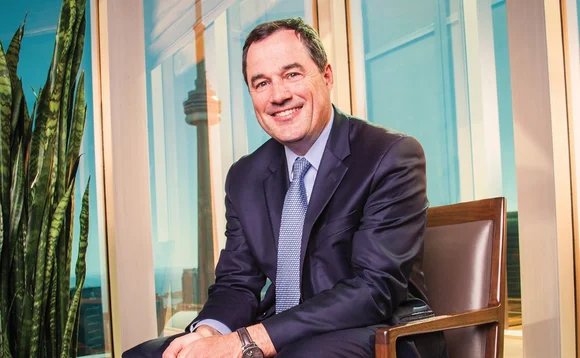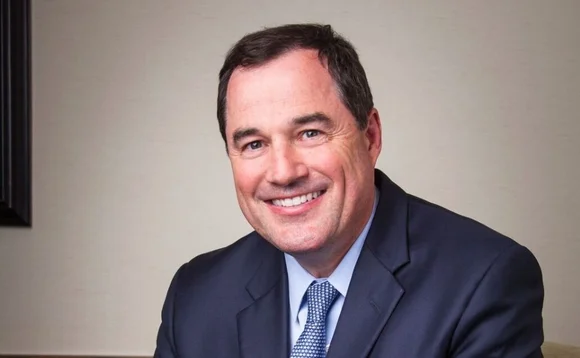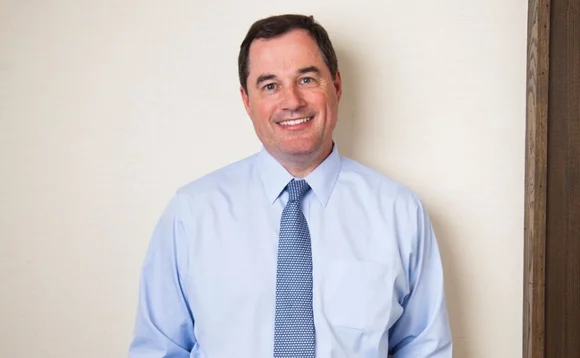Reinventing RBC: Royal Bank of Canada's Bruce Ross
Bruce Ross was tasked with leading the Royal Bank of Canada’s transformation of its technology department when he was named head of technology and operations at the Toronto-based bank in January 2014.





Ross talks with Dan DeFrancesco about the progress made over the past two-and-a-half years and what still needs to be done. Photos by Eric Forget
There is a war going on in the technology department at the Royal Bank of Canada (RBC).
But there is no need to call in the Mounties, Canada’s federal police, for this particular battle, although the lack of bloodshed doesn’t mean the tension between the two sides isn’t high. To get a first-hand view of what’s taking place at the Toronto-based bank, just head to the technology group on any given day to see both sides’ colors on display. There is blue for the Toronto Maple Leafs and red for the Montreal Canadians.
The two teams are the oldest active Canadian teams in the National Hockey League (NHL) and the only two Canadian members of the Original Six, a group of six teams that made up the league from 1942 to 1967 and are still active today. Fans of both teams are happy to represent their respective teams at work, leading Bruce Ross, RBC’s head of technology and operations, to categorize the entire technology department as having “a lot of team spirit.”
In fact, it all started with Ross. After spending nearly three decades holding various roles at IBM, Ross made the move back to his hometown to take on the role of head of technology and operations for RBC in January 2014. Upon taking the reins, he recognized another war that was taking place at nearly every financial firm: the fight for young technologists.
“IBM taught me that living and working in a global world—especially when you’re embedded within the cultural fabric of those countries—you learn a tremendous amount. Not only how business works, but how people react, how to engage a team and the clients, and then the curiosity just to test yourself and to continue to see what the next day will bring.”
For Ross—a strong believer in always keeping a good pulse on his clients and employees—amending the dress code was a simple fix for how the bank could improve recruitment. As Ross sees it, just because he grew up wearing a suit and tie doesn’t mean his employees have to.
“When you ask people to do something in terms of what they wear, and that’s not necessarily what they want, then you’re actually tying one hand behind your back,” Ross says. “I look at it from a competitive position that we need to relax a bit—open up and realize that we’re in a different era, and we need to be able to appeal to those people.”
And so, if an RBC employee feels comfortable wearing a tie, they can wear a tie. And if they feel comfortable wearing jeans and a t-shirt, they can wear jeans and a t-shirt. Ross only has two requests: that you’re comfortable with the way you look in the mirror; and if you saw what you were wearing on someone else out in public, you wouldn’t be offended.
Implementing a more casual dress code at a bank certainly isn’t a groundbreaking feat, but it does represent a microcosm of Ross’ tenure with RBC thus far. His two-and-a-half years at the bank have been full of changes made to keep the firm in the top spot among Canadian banks, and the movement doesn’t look to be changing anytime soon.
“As financial institutions, we have to look at more where the market is going and how we adapt to the market as opposed to having the market adapt to us,” Ross says.
IBM Upbringing
At first glance, Ross doesn’t seem to fit the mold of someone who so willingly accepts change. This is the man, after all, who spent the majority of his career with one company. Ross graduated from the University of Western Ontario, now known as Western University, and immediately nabbed a job with IBM in 1985. It took just under 30 years for him to switch firms, but his time at the technology giant certainly wasn’t stagnant. He spent time based in Toronto, New York, Boston, London and Madrid, as he climbed the corporate ladder, eventually reaching the role of general manager of global technology services for North America.
Prior to that, Ross got a taste of everything at IBM. There were the two years he spent running IBM Canada, in which he was in charge of everything from manufacturing through to the lab and client interface. He also ran IBM services for all of western and central Europe.
“We’ve got Canadian parents, American kids and English dogs, and we’ve got all that thanks to IBM,” Ross says. “IBM taught me that living and working in a global world—especially when you’re embedded within the cultural fabric of those countries—you learn a tremendous amount. Not only how business works, but how people react, how to engage a team and the clients, and then the curiosity just to test yourself and to continue to see what the next day will bring.”
Opportunities, Not Challenges
So what could possibly make someone want to leave a place where they’ve spent their entire career? And why would someone at a pure technology company want to make the move into financial services? It would have been easy for Ross to be an IBM lifer. There were plenty of challenges at the company. The firm was in the process of moving from a traditional services model to cloud computing, and as Ross puts it, he’s not the type of person to leave during a fight.
But the travel had taken its toll. His two sons had been in six different schools before the age of 10. He wanted to put his roots down somewhere, and what better place than his hometown? That wasn’t the sole reason, though. Ross always had an interest in applying technology to real business problems.
As the top bank in Canada with $880 billion ($1.15 trillion CAD) in assets under management as of April 30, RBC has plenty of challenges—or opportunities, as Ross likes to call them—to dig into. The move back to Toronto to take the RBC job wasn’t about riding slowly into the sunset for Ross. Simply running the operational back office of the bank, while a massive responsibility on its own, wouldn’t be enough to entice him to make the switch. The ever-evolving market, changing client demands and the new technologies tasked with addressing them are what really excited Ross.
“I’m not here just for the status quo,” Ross says. “I have absolutely too much energy and excitement. I want to stay away from that type of thing.”
Understanding the Situation
So what exactly is Ross pouring his energy into? Plenty of things, it turns out. Upon arriving at RBC he immediately defined what the strategy was for the IT organization and how it aligned with the business. He then evaluated RBC, comparing it to benchmarks in the industry. It was an easy task thanks to his time at IBM, which gave him a good view of what the bank’s peer group looked like.
Speed to market of application development, the use of cloud technology and Agile methodology, leveraging data, data governance and the underlying infrastructure were all areas where Ross saw room for improvement. He eventually created four categories, looking at the efficiency of systems, cyber-security and the client experience, which was broken up into evaluating the current systems and making sure the bank was also developing leading-edge technology.
“We said, ok, here are the gaps that we need to fill, and then went ahead and executed on them and set lofty goals,” Ross says. “I’m a big believer that you’ve got to set the bar high, have ambition, and then see how you do against it, especially in a market that’s moving quickly.”
Progress
After two-and-a-half years at the helm, the results have come across the board for RBC.
The reliability of RBC’s environments is up, according to Ross, and the bank is able to process change faster. He says the firm can execute a couple of thousand changes per month within the organization, it can scale quicker, and is more reliable than before.
Cybersecurity has improved as well, according to Ross, but it’s not just about avoiding major incidents. The bank’s insight around its protection has improved. As Ross puts it, it’s about more than just stopping people coming in through the front door.
“If you actually get into my yard, I can see you and I can react much faster,” Ross says. “I have a level of analytics inside there that I can actually turn what’s in 1s and 0s that technology people are interested in into actual English that business people understand.”
The firm has also adopted a bring-your-own-device policy (BYOD), migrating away from what used to be a largely BlackBerry-based organization. That includes opening up RBC’s app store with a lot of productivity apps that come out on a monthly basis.
A data marketplace is in the process of being created. Ross says the bank wants to create an environment where an employee with the right authority and business needs can access data without having to ask for permission. The same concept is being brought to analytics, offering users easier access to deep functionality.
“We’re able to get much more predictive in terms of actions that we take,” Ross says. “How are people going to respond?”
RBC has also developed data lakes and put Hadoop technology on top, a project largely driven by regulation. Ross cites the Basel Committee on Banking Supervision’s regulation 239 (BCBS 239) and the Volcker Rule as specific regulations that have been early use-cases.
“Some of the biggest lessons we’ve learned as we’ve gone through the efforts in things like BCBS 239 have been the ability to aggregate data,” Ross says. “Being able to manage that data and doing it holistically across multiple businesses, because we run five significant businesses here at RBC, so risk data aggregation has been key.”
Cloud Concerns
One of Ross’ biggest projects at RBC has been the firm’s movement into the cloud. It’s a familiar endeavor, as it was one IBM was pursing when he left the firm, and it’s an area the bank has spent the past two years investing in. The goal of the movement, Ross says, boils down to the speed at which RBC can get capability into the hands of its clients and the ability to churn out product releases as often as possible. It’s a mindset Ross has brought over from a career at a technology company where product cycles are far shorter.
Currently, RBC runs in a hybrid-type environment, Ross says. The firm uses a public cloud, although RBC also has a private cloud and production datacenters. Ross declines to get into specifics, but says over 40 percent of the development testing world is in a hybrid cloud. The production cloud isn’t at that capacity, but it is ramping up. The goal is for all new applications to be born in the cloud, according to Ross.
The real business case Ross sees when it comes to cloud computing is in platform-as-a-service (PaaS).
“It’s our ability to piece together technology in real time, quickly. Building this API marketplace, leveraging that internally and externally and creating the continuous integration from the development cycle to the engineering right through to the production,” Ross says. “That’s forcing IT shops to think about things differently. They used to have the vertical of application development and infrastructure, and they would meet in the cafeteria, but not at a lot of other times. Now it’s actually forcing those boundaries to, in many cases, go away.”
Even now, as the top technology man at the biggest bank in Canada, the competitive spirit hasn’t left Ross. Whether it’s cloud computing or dress codes, Ross believes his work at RBC will never be done. There will always be something new on the forefront. Because if there is one thing Ross has learned in his three decades in the workforce, it’s that the battle never ends.
“I think you find that almost any financial institution is on a journey, and I’m not sure you’re ever done, especially in technology. When I worked at IBM, did I ever think I was done? No,” Ross says. “The day you actually think you’re done is the day someone knocks you off your perch.”
Bruce Ross Fundamental Data
Name: Bruce Ross
Age: 53
Birthplace: Toronto
Title: Head of technology and operations at RBC
Assets Under Management: $880 billion ($1.15 trillion CAD)
Education: Engineering degree from University of Western Ontario
Hobbies: Sailing, carpentry, skiing, rowing, spending time with family
Only users who have a paid subscription or are part of a corporate subscription are able to print or copy content.
To access these options, along with all other subscription benefits, please contact info@waterstechnology.com or view our subscription options here: http://subscriptions.waterstechnology.com/subscribe
You are currently unable to print this content. Please contact info@waterstechnology.com to find out more.
You are currently unable to copy this content. Please contact info@waterstechnology.com to find out more.
Copyright Infopro Digital Limited. All rights reserved.
As outlined in our terms and conditions, https://www.infopro-digital.com/terms-and-conditions/subscriptions/ (point 2.4), printing is limited to a single copy.
If you would like to purchase additional rights please email info@waterstechnology.com
Copyright Infopro Digital Limited. All rights reserved.
You may share this content using our article tools. As outlined in our terms and conditions, https://www.infopro-digital.com/terms-and-conditions/subscriptions/ (clause 2.4), an Authorised User may only make one copy of the materials for their own personal use. You must also comply with the restrictions in clause 2.5.
If you would like to purchase additional rights please email info@waterstechnology.com
More on Emerging Technologies
Tape bids, algorithmic trading, tariffs fallout and more
The Waters Cooler: Bloomberg integrates events data, SimCorp and TSImagine help out asset managers, and Big xyt makes good on its consolidated tape bid in this week’s news roundup.
DeepSeek success spurs banks to consider do-it-yourself AI
Chinese LLM resets price tag for in-house systems—and could also nudge banks towards open-source models.
Standard Chartered goes from spectator to player in digital asset game
The bank’s digital assets custody offering is underpinned by an open API and modular infrastructure, allowing it to potentially add a secondary back-end system provider.
Saugata Saha pilots S&P’s way through data interoperability, AI
Saha, who was named president of S&P Global Market Intelligence last year, details how the company is looking at enterprise data and the success of its early investments in AI.
Data partnerships, outsourced trading, developer wins, Studio Ghibli, and more
The Waters Cooler: CME and Google Cloud reach second base, Visible Alpha settles in at S&P, and another overnight trading venue is approved in this week’s news round-up.
Are we really moving on from GenAI already?
Waters Wrap: Agentic AI is becoming an increasingly hot topic, but Anthony says that shouldn’t come at the expense of generative AI.
Cloud infrastructure’s role in agentic AI
The financial services industry’s AI-driven future will require even greater reliance on cloud. A well-architected framework is key, write IBM’s Gautam Kumar and Raja Basu.
Waters Wavelength Ep. 310: SigTech’s Bin Ren
This week, SigTech’s CEO Bin Ren joins Eliot to discuss GenAI’s progress since ChatGPT’s emergence in 2022, agentic AI, and challenges with regulating AI.








